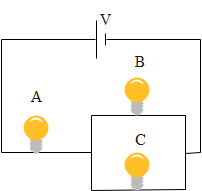
In the circuit shown, three identical light bulbs connected to a battery. The brightness of the bulb

1) A < B = C
2) A > B = C
3) A = B = C
4) A < B < C

Answer
476.4k+ views
Hint: The brightness of a bulb is directly proportional to the amount of current flowing through the bulb. The bulbs are identical and by using the fact that the current will remain same for the bulbs connected in series while the voltage will remain same in the parallel combination of bulbs, we can compare the brightness of the various bulbs.
Complete step by step answer:
We are given an electric circuit which has three identical light bulbs connected to a battery as shown in the circuit.
Since the bulbs are identical then let R be the resistance of each bulb. For the two bulbs connected in parallel with each other, the equivalent resistance is given as
$
\dfrac{1}{{{R_P}}} = \dfrac{1}{R} + \dfrac{1}{R} = \dfrac{2}{R} \\
{R_P} = \dfrac{R}{2} \\
$
Now the equivalent resistance of the whole circuit is given by the series combination of R and ${R_P}$ as follows:
${R_{eq}} = R + {R_P} = R + \dfrac{R}{2} = \dfrac{{3R}}{2}$
Now the total current through the circuit can be written as
$I = \dfrac{V}{{{R_{eq}}}} = \dfrac{{2V}}{{3R}}$
Since current remains same in the series combination, the current through bulb A is given as
${I_A} = \dfrac{{2V}}{{3R}}$
In a parallel combination of bulbs B and C, the current gets equally divided between B and C since their resistances are the same. So, the currents through them are given as
${I_B} = {I_C} = \dfrac{V}{{3R}}$
Therefore, we have
${I_A} > {I_B} = {I_C}$
Now as we know that brightness of the bulb is directly proportional to the amount of current flowing through the bulb, therefore the brightness of the bulbs is also given in the same way as the above expression as follows:
A > B = C
Hence, the correct answer is option 2.
Note:
It should be noted that the bulbs which are connected in parallel to each other have the same brightness. Because of this reason, it is advisable to connect devices in parallel to each other so that they have brightness rather than in series, where the brightness can be different.
Complete step by step answer:
We are given an electric circuit which has three identical light bulbs connected to a battery as shown in the circuit.
Since the bulbs are identical then let R be the resistance of each bulb. For the two bulbs connected in parallel with each other, the equivalent resistance is given as
$
\dfrac{1}{{{R_P}}} = \dfrac{1}{R} + \dfrac{1}{R} = \dfrac{2}{R} \\
{R_P} = \dfrac{R}{2} \\
$
Now the equivalent resistance of the whole circuit is given by the series combination of R and ${R_P}$ as follows:
${R_{eq}} = R + {R_P} = R + \dfrac{R}{2} = \dfrac{{3R}}{2}$
Now the total current through the circuit can be written as
$I = \dfrac{V}{{{R_{eq}}}} = \dfrac{{2V}}{{3R}}$
Since current remains same in the series combination, the current through bulb A is given as
${I_A} = \dfrac{{2V}}{{3R}}$
In a parallel combination of bulbs B and C, the current gets equally divided between B and C since their resistances are the same. So, the currents through them are given as
${I_B} = {I_C} = \dfrac{V}{{3R}}$
Therefore, we have
${I_A} > {I_B} = {I_C}$
Now as we know that brightness of the bulb is directly proportional to the amount of current flowing through the bulb, therefore the brightness of the bulbs is also given in the same way as the above expression as follows:
A > B = C
Hence, the correct answer is option 2.
Note:
It should be noted that the bulbs which are connected in parallel to each other have the same brightness. Because of this reason, it is advisable to connect devices in parallel to each other so that they have brightness rather than in series, where the brightness can be different.
Recently Updated Pages
How do you factor x2 + x 20 0 class 9 maths CBSE

How do you solve y6x and 2x+3y20 using substitutio class 9 maths CBSE

Chipko movement originated in Gopeshwar in A 1953 B class 9 biology CBSE

The adjacent sides in the parallelogram are supplementary class 9 maths CBSE

The compound used in plastic industry is A Vinyl acetate class 9 chemistry CBSE

How do you solve for y in 2left y dfrac12 right 4left class 9 maths CBSE

Trending doubts
Types of lever in which effort is in between fulcrum class 12 physics CBSE

Distinguish between esterification and saponification class 12 chemistry CBSE

Which are the Top 10 Largest Countries of the World?

A two input XOR Gate produces a high output only when class 12 physics CBSE

Give five points to show the significance of varia class 12 biology CBSE

Which is the correct genotypic ratio of mendel dihybrid class 12 biology CBSE




